Global boom lifts
31 July 2018
Booms are the workhorses of the access world. They also define the future of the industry and the direction it will take. Euan Youdale reports.
Two of the major topics of recent times has been the increasing number of new MEWP manufacturers and the new ANSI and CSA standards being introduced in North America.
Another major topic can now be added to that list – electrification and hybridization. Hybrid and electric MEWPs have been around for years in one form or another but it is the noticeable move into rough terrain machines that is catching the attention of the industry.
It is no real shock that electric equipment will become a necessity in a world that is bringing in strict emissions regulations, particularly in city centres. Nevertheless, it was clear at Intermat this year - the biggest construction exhibition of 2018 - that electric and hybrid solutions were now at the heart of many companies’ agendas.
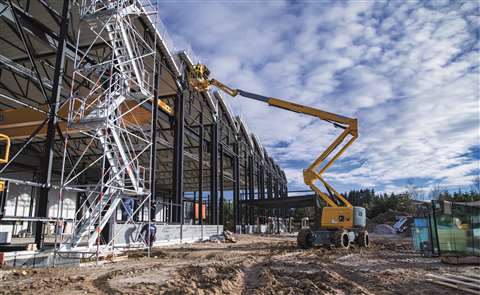
One of the companies making its eco-friendly mark at the show this year was Haulotte. The company announced that all future self propelled boom products launched by Haulotte will be electric powered. The new Haulotte Pulseo Generation range of rough terrain booms marks the beginning of the strategy and is first represented by the 21m working height HA20 LE and HA20 LE Pro.
Haulotte is the first MEWP manufacturer to commit to all-electric powered platforms. Speaking at Intermat, Haulotte COO Alexandre Saubot confirmed no boom products powered by purely by internal combustion engines will be launched from now on. “We want to be in the right position in the value chain and we want to put our customers in the right place in the value chain.
Electric future
Saubot explains that some existing diesel models will remain in the line-up for customers that require them. Although he adds, “We don’t know how long it will be before we get rid of all diesel machines but it will happen.”
As one might expect, this means there will be plenty more launches in the Pulseo Generation over the months and years to come. Equipped with non-marking tyres, the Pulseo models are suited to all indoor work but also have an oscillating axle and 4-wheel drive for outdoor work.
The company also points out the machines are designed to offer the same level of performance as their diesel counterparts. The Ultra-fast elevation speed, 360° continuous turret rotation and simultaneous movements work together to enhance this productivity.
High-capacity batteries and the ability to lower the basket using gravity instead if any power source maximises battery performance for a full day’s work. If extended battery power is required, then there is an on-board combustion engine for recharging the batteries, while the machine retains its full operating capacity during the charge cycle. Haulotte believes the rest of the world will follow suit due to new and oncoming emission regulations.
“Cities across the globe must rise to the same challenge,” says Saubot, “To tackle air pollution, fight global warming and offer their citizens the best possible living conditions. These constraints lead to the development of environmentally-friendly alternative energies; that means eco-responsible booms.”
Genie was showing its new generation of environmentally-friendly MEWPs at Intermat, along with additions to its Xtra Capacity (XC) boom lift family. Hybrid and electric models on show were the 20m Z-60/37FE hybrid articulating boom lift, 12m Z-33/18 electric articulating boom and an upgraded model of its electric Genie GS-4047 scissor lift.
Genie told AI at the show that ‘green’ access equipment was becoming more popular in young and emerging access markets, as well as in mature markets like Europe. For example, China is set to skip Tier 4 standards and go straight to Tier 5. This means that in the future it will be less easy to sell old equipment, as emerging markets will increasingly require the latest emission-friendly equipment too.
It also means that new equipment will have to cover all eventualities and while Genie has no plans to move to exclusively electric launches, it will see Genie expanding its product ranges along the lines of the FE hybrid and bi-energy equipment.
Key advantages
The practical side of developing electric and hybrid technologies is that customers will be able to use one machine for many or even all of their tasks. Starting with hybrid products JLG has just launched one of the world’s largest boom in this category, to nearly match that of Niftylift’s existing range-topper, the 28m HR28.
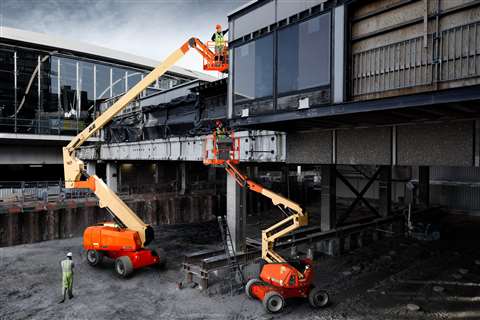
The rough terrain articulated H800AJ has a 26.38m (80ft) working height and horizontal outreach of 15.8m. The model adds to JLG’s range of hybrid articulating booms in lower working heights. As Jan-Willem van Wier, JLG’s product manager for EMEA/Russia, points out, the trend is towards being Zone complaint, which has taken a further leap forward since the United Nations’ Paris Agreement concerning climate change in 2016.
The machine has an 84 volt system. It can operate in electric mode only and has a 20.9 kW generator, combined with an electric motor. “It’s a parallel hybrid which allows the motor to kick in during rough situations or when you need the batteries to charge,” explains van Wier, “If you are on a job site where no power has been installed you still need to charge the batteries overnight, which can be done in roughly four hours.”
Bedsides charging, the parallel system allows the generator to aid the electric motor in rough situations when extra power is needed, like raising the boom, driving through thick mud and heavier applications. (See the Electric/hybid feature, AI April-May for more details).
As an aside, earlier this year JLG also launched crawler versions of the 600 telescopic boom lift series. The wheeled 600S and 660SJ lifts were launched at Conexpo in 2017 and now the company has announced the crawler versions, the 600SC and the 660SJC, bringing the series to four models. (See www.khl.com/ai for more details).
One of the reasons manufacturers are taking quicker steps towards hybrid and electric is that the specific regulations for diesel engine emissions are becoming more difficult to meet.
Meeting demands
Manitou recently launched its latest booms, the 160/180 ATJ models. The launches reflect the importance the French company is placing on its growing AWP line, as well as the main objective of being ready for European Stage 5 regulations. “Our engineers have completely reworked the powertrain, from axles to the engine. We also added a load sensing pump for better steering precision,” says Samuel Viaud, global product manager AWP.
And both models now have as standard a Stop and Go system to reduce fuel consumption and increase the resale value. In addition, the rough terrain performance has been improved, including 45% gradeability. “We will continue to work on the tage V standard on all models and modernize our current range.”

For the electric machines generally, the worldwide market has grown strongly, by 18%, says Viaud, “and will continue to grow with all the restrictive standards concerning pollutant gas emissions and the emergence of more versatile electrical machines. The current trend towards environmental friendliness are encouraging manufacturers to explore new technologies,” adds Viaud.
The manufacturer started selling MEWPs in North America just this year, which is another indication of its desire to grow its market share. And it’s a reflection of the growing competition in the MEWP sector. It was back in February the company introduced a line of diesel booms to the continent, mainly based on its existing range, including the new articulating ATJ 46. The 45ft 11 inch platform height ATJ 46 introduces an automatic start/stop system and 24 hp Kubota engine that does not require after treatment.
Mark Hanson, regional vice president of Manitou Group and CEO of Manitou North America, said, “All five new models were engineered to comply with the proposed North American ANSI standards. Significant changes include modifications to the electrical system, a swing door on the basket and new Tier IV engines for the diesel models.
On the subject of ANSI, Genie has been making a major play of its Xtra Capacity (XC) range of booms that have been designed as a global product but very much with the new North American standards in mind. Marie Engstrom says we can expect to see the continued evolution of the Genie XC. “Genie XC booms allow more workers in the platform to carry greater loads than they could before in a wide range of environments.”
This means platforms can be loaded to 660 pounds (300kg) in the maximum outreach zone and 1,000 pounds (454kg) in the maximum capacity zone. This dual-capacity feature results in greater productivity while meeting the latest compliance levels for the pending ANSI A92 and CSA B354 in North America, as well as the current European EN280 and Australian AUS 1418.10 standards.
The Genie XC boom range currently includes the Z-45 XC, S-60 XC, S-65 XC, S-80, S-85 XC, SX-105 XC, SX-125 XC and SX-135 XC models. This first Genie XC model to be introduced was the Genie SX-135 XC in the third quarter of 2016. The rest of the models were introduced in 2017. More models will be coming in 2018 and the following years, says the company.
Extra productivity
With all the discussion of emerging markets and ecological requirements, there is another area of importance. “Workers are increasingly asked to be more productive while keeping a close eye on safe work practices when operating both articulating and telescopic booms,” says Engstrom.
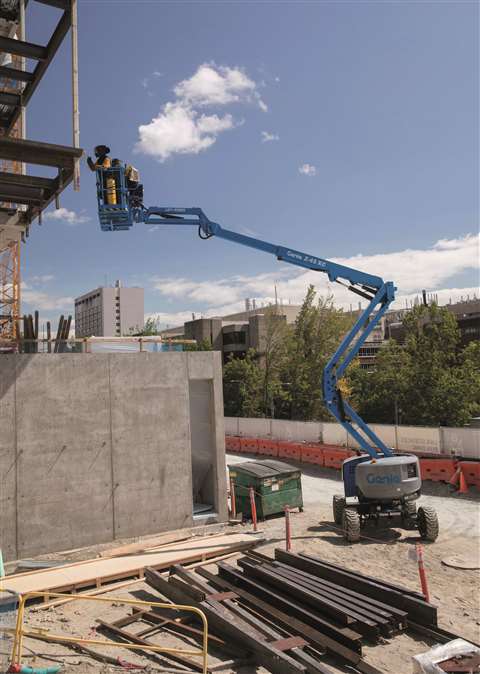
With the increased dual capacity of the XC line, machines also allow for up to three occupants in the platform, which gives a larger boost to productivity. As product manager Corrado Gentile explains, the Genie SX-105 XC, SX-125 XC and SX-135 XC models also feature the new Genie mini XChassis, a pivoting axle system which offers enhanced durability and serviceability over outdated tube-in-tube axle systems. All Genie XC models are equipped with a state-of-the-art CAN-based diagnose and troubleshooting control system.
Sean Larin, also a Genie product manager, adds, “This increased capacity will enable machine operators to lift the heavy loads needed on even the most demanding jobsites, while the load sensing technology is a robust system designed to monitor the weight in the platform day in and day out.”
Concerning the new ANSI/CSA standards, Matt Elvin, Snorkel’s CEO, says there are mixed feelings from rental companies towards this change. “It does have the potential to increase the number of service calls, at least initially. However, this is mostly being viewed as a positive change which can help to protect equipment from overloading, which may result in incidents or equipment damage, all of which put a burden on the rental equipment owners.”
In late 2017, Snorkel released two new mid-size telescopic booms into full US production – the 600S and 660SJ. The Snorkel 600S provides a maximum working height of 20.3m (66ft) and an outreach of 15.9m (52ft 2 in). The heavy-duty, all-steel Snorkel 660SJ lift is 2.46m (8ft) wide with a stowed length of 10.5m (34ft 2in), which can be reduced to 8.5m (28ft) for transport by stowing the 2m (6ft 6 in) jib boom underneath the main boom.
These telescopic boom models feature Snorkel’s 2.44m x 0.91m (8ft x 3ft) tri-entry platform and all proportional boom functions, including jib and platform rotate.
Mid-size launch
In 2018, Snorkel will be releasing the new 400S and 460SJ mid-size telescopic boom lifts into production. The Snorkel 400S delivers a working height of up to 14.2m (46ft) and an outreach of 10.1m (35ft). The Snorkel 460SJ offers a working height of 16m (52ft) and outreach of up to 12.8m (42ft), with a 2m (6ft 6 in) jib boom for additional flexibility. Designed for construction sites, the Snorkel 400S and 460SJ deliver up to 50% gradeability and constant four-wheel drive from the standard fixed axles.
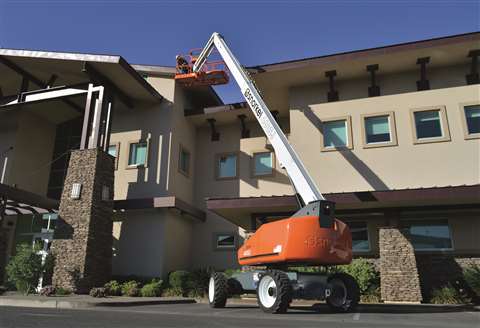
“In response to the requirement for increased productivity from within our customer base, we are continuing to see demand for higher capacity lifts,” says Elvin, “As demonstrated by our latest line of mid-size telescopic boom lifts, we are already designing our new lines with higher than industry standard capacities. The new Snorkel 660SJ, for example, has an unrestricted lift capacity of 272kg (600 lbs). We anticipate that this trend will continue, and as such we are giving greater focus within our research and development process as to how we increase capacity without increasing dimensions and/or weight.”
Karin Nars, sales director at Dinolift, agrees that, “Customers are asking for it all.” This means greater working height and outreach, simultaneously with bigger basket and SWL. “For thinner and stronger materials some manufacturers will have to adopt new welding methods as well which bring less heat to the thin materials.”
And for a manufacturer like Dinolift, with its unique products, this challenges also offer opportunities. In 2017 Dinolift, based in Finland, introduced the 28m working height Dino 280RXT - a lightweight 4x4 wheeled boom lift with outriggers. This latest model has been designed to take the series to a new level of performance while maintaining the original idea of low overall weight. Combining 28m working height and 16m horizontal reach with less than 5000kg overall weight and 10km/h transportation speed, the machine also utilises a completely new boom design with ultra-high strength steel.
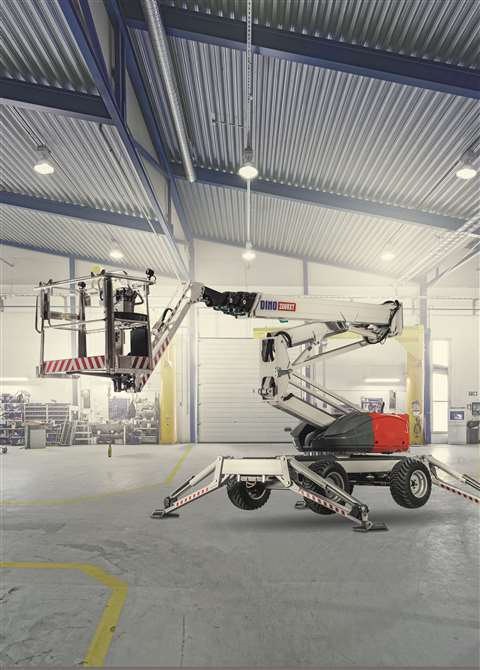
In the near future Dinolift will continue to focus on lightweight boom lifts with outriggers. Nars says, “Weight reduction has multiple benefits such as the ability to use smaller engines with lower fuel consumption, reduced maintenance cost and efficiency in transporting equipment from site to site. While low in weight, the machines can solve access problems in soft terrain efficiently without additional matting.”
For a European manufacturer like Dinolift the change in North American standards have made the market more appealing. “The standards are closer to the EN standard for MEWPs – therefore making the standard machines easily converted to meet the new ANSI/CSA standards.
“As far as designing new machines is concerned, it makes life easier to have more uniform nearly global standards for machines. From the first design sketch of the new 280RXT it was clear that the new ANSI/CSA will have to be complied with as well as the EN standards.
From the sales point of view the global access equipment market becomes ‘smaller’. “Smaller companies wi th limited resources from Europe will access the North American market easier than before – at the same time the North American customer will continue benefitting from the European style machines that maybe targeted at a smaller niche markets.”
Diverse needs
Concerning new and expanding players on the scene, Magni’s Eugenio Magni said the company is still working on the booms it has designed for China-based Dingli. The Italian manufacturer is European distributor for Dingli’s scissor lifts and is making a significant impact on that market with that product type.
The first prototypes from Dingli’s boom line were shown in 2016 at Bauma China. They followed Dingli’s investment of 20% of Magni, which went on co-create the booms, which ultimately are being produced in China at the Dingli factory.
Magni told AI at Intermat that the updated and production-ready versions of that boom line are likely to be presented at Bauma China this year. They will retain their unique design of China products not quite there yet: But maybe soon.
Another manufacturer from China, LGMG – a generalist construction equipment company that has branched into MEWPS – has become one of the country’s major players in the last couple of years. As expected it started out with scissors but is now half way through a three-year plan to develop a complete range of platforms to cover all a typical rental company’s needs. This, of course, includes a full range of booms. (See the AccessM20 in this issue for LGMG’s revenue in 2017).

In Europe, JCB Access was launched early last year and has already started to make an impression with its scissor lifts. Its plan too, is to provide a complete range of booms that would cover the core 80% of any rental company’s products needs. The company told AI that its complete articulated boom range would be in full production at the end of October, ready for orders in the new Year. Its telescopic booms will be brought in between January and June next year, starting with the smaller models.
ELS, the manufacturer formed in Turkey some six years ago, has been steadily growing its range with new scissors and vertical masts. See the Intermat review in this issue for those launches. This equipment, company president Kerem Bayrak tells AI, will be followed by new electric booms next year to add to the company’s 15m working height model, along with rough terrain articulating booms. The latter will include a hybrid version, with either 16m or 17m working height. “In Turkey hybrid is very new. People do not want it now but other European customers do,” says Bayrak.
To accommodate this product expansion ELS is introducing new assembly lines, with new painting and robotic assembly to complement it, which again will be operational this year.
First delivery
Skyjack has delivered its first Australian order of SJ85 AJs to Botany Access earlier this year. This order initiated the first SJ85 AJs heading to job sites in Australia.
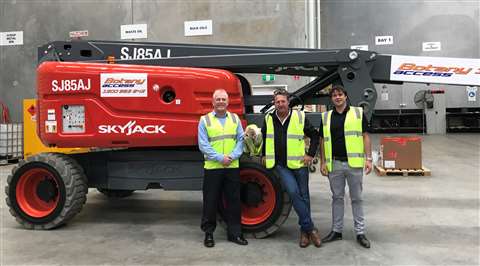
“Skyjack’s service and support is always on the ball and the machines’ reliability is second to none,” said Dave Wright, service manager at Botany Access. “We saw the SJ85 AJ at Vertikal Days and with its dual capacity, EasyDrive, and SpeedyReach, I knew this was a product that our customers would want to hire.:
The SJ85 AJ is Skyjack’s largest articulating boom and has a working height of 27.74m (91 feet), up and over clearance of 10.36m (34 feet) and a horizontal outreach of 17.07m (56 feet.) The open-center knuckle design also means the fly boom can be lowered to ground level for re-stocking without lowering the riser, which increases job site efficiency.
“With our expansion across the east coast we need to partner with manufacturers who can support our growth and give us the service we need,” said Managing Director of Botany Access, Justin Brownbill.
High altitude
Konsag, a building conservation specialist in Switzerland, has ordered a Puma 42GTX from Teupen.
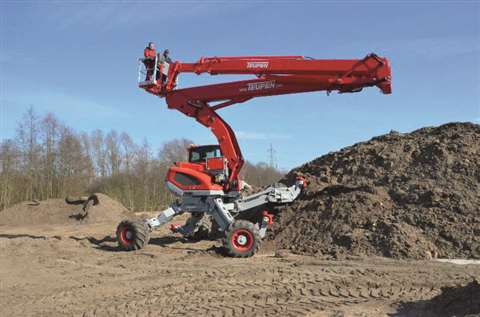
The company said it would use the 42.7m working height ultra-rough terrain lift as an all rounder in its fleet. “The Puma can be used like a boom lift or a truck mounted aerial platform, but its ability to adapt and cross-country mobility is unique,” said Michael Wys, founder of Konsag.
Launched in 2016 at Bauma, the Puma is a unique combination of a Menzi Muck walking excavator chassis and an aerial work platform, based on Teupen’s Leo series of tracked lifts.
The unit will be equipped for the first time with a W135M cable winch, with mooring function for extreme terrain. It will be used at Jungfrau, Europe’s highest railway station, which is based in the Alps and is 3,454m above sea level.






